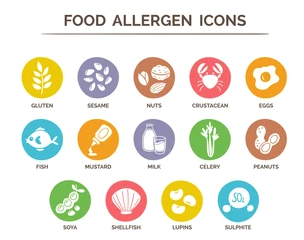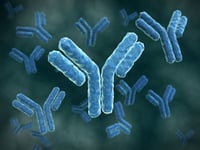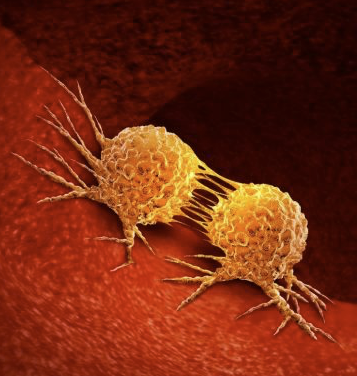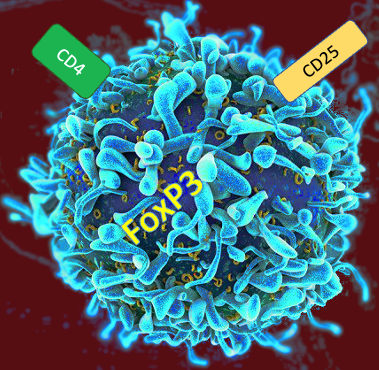 Ever since the official start of spring, I have been sneezing repeatedly with watering eyes possibly due to the various types of pollen and random detritus in the air. No matter your location or the time of year, we are always swimming in potential allergens, and some of us react to these generally innocuous substances more intensely than others. As summer is often a time of heavy pollination, let's explore allergies and what can be done about them.
Ever since the official start of spring, I have been sneezing repeatedly with watering eyes possibly due to the various types of pollen and random detritus in the air. No matter your location or the time of year, we are always swimming in potential allergens, and some of us react to these generally innocuous substances more intensely than others. As summer is often a time of heavy pollination, let's explore allergies and what can be done about them.
Ever-Present Allergens!
There are huge libraries of information both in the actual physical library and on the glorious internet about allergens and how to treat and manage allergies, mostly because more than 50 million people in the United States alone suffer from allergic reactions each year. Taking into account all the different manifestations, allergy is the sixth-leading cause of chronic illness in the USA, and according to the Asthma and Allergy Foundation of America, allergies affect about 30% of adults and 40% of children. The health care costs due to allergies alone could exceed $18 billion. Because our immune systems are unique to us, anything could become an allergen to trigger an exaggerated response, including food, pollen, animals such as our pets or stinging insects, drugs, and things you might use in the lab like latex gloves.
You may have noticed a light dusting on your car parked under shade trees, or the thin layer of actual dust on all the LEGOs you (read: me) were supposed to clean but didn't this week. Aside from making a slight mess, some of these particles will eventually make it into your airways and cause you to sneeze, which is a natural reaction to get rid of foreign materials. For those of us who have allergies to particular types of particles, essentially the immune system is now overreacting to an otherwise harmless substance, and that reaction can range from mildly inconveniencing to life-threatening. While it was en vogue to blame this on the disproportionate planting of male plants in urban development, pollination and other plant-based allergens are just a fact of life. The prevalence and seriousness of allergies and its effects on health care and society explain the myriad websites that provide information to help people manage their symptoms, and the literal pallets of Costco generics to Zyrtec, Claritin, and other antihistamine and anti-allergy drugs.
 In the United States, the Food and Drug Administration (FDA) is particularly vigilant in helping consumers identify if food items contain common allergens that could cause serious health issues. Due to the hospitalizations and deaths that could result from severe food allergies, the Food Allergen Labeling and Consumer Protection Act (FALCPA) was enacted in 2004 and the Food Allergy Safety, Treatment, Education, and Research (FASTER) Act in 2021 to alert consumers to the presence of these common allergens that include milk, eggs, seafood, various nuts, and even sesame. I feel fortunate that I do not suffer from any major food allergies (although the lactose intolerance can be a bit of a bummer) and I wasn't even aware that sesame could be an allergen, but for those who do, the symptoms can range from skin irritation to gastrointestinal distress to emergencies such as anaphylaxis which if untreated could lead to death. In fact, food allergies are a common trope in literature and movies as plot devices, especially in thrillers and murder mysteries! I guess if you have to eliminate a troublesome character or cause some humorous adversity in your story, just slip them some peanuts or shellfish and make it look like an accident, not that I'm advocating for foul play, mind you.
In the United States, the Food and Drug Administration (FDA) is particularly vigilant in helping consumers identify if food items contain common allergens that could cause serious health issues. Due to the hospitalizations and deaths that could result from severe food allergies, the Food Allergen Labeling and Consumer Protection Act (FALCPA) was enacted in 2004 and the Food Allergy Safety, Treatment, Education, and Research (FASTER) Act in 2021 to alert consumers to the presence of these common allergens that include milk, eggs, seafood, various nuts, and even sesame. I feel fortunate that I do not suffer from any major food allergies (although the lactose intolerance can be a bit of a bummer) and I wasn't even aware that sesame could be an allergen, but for those who do, the symptoms can range from skin irritation to gastrointestinal distress to emergencies such as anaphylaxis which if untreated could lead to death. In fact, food allergies are a common trope in literature and movies as plot devices, especially in thrillers and murder mysteries! I guess if you have to eliminate a troublesome character or cause some humorous adversity in your story, just slip them some peanuts or shellfish and make it look like an accident, not that I'm advocating for foul play, mind you.
Diagnosing Allergies
 Per the Mayo Clinic, people are more likely to develop an allergy if they have a family history or have asthma. It is easier to develop allergies as a child, and if you or your loved ones have symptoms of allergies, it is best to seek a confirmation from a medical professional, particularly an allergist who will specialize in these ailments.
Per the Mayo Clinic, people are more likely to develop an allergy if they have a family history or have asthma. It is easier to develop allergies as a child, and if you or your loved ones have symptoms of allergies, it is best to seek a confirmation from a medical professional, particularly an allergist who will specialize in these ailments.
Per the Cleveland Clinic, tests can be performed to confirm the allergens that are inducing your symptoms. These tests include a skin prick, or a scratch test, that introduces a small amount of common allergens to specific areas of your skin to see which of the test allergens you will react to. Another test is based on circulating IgE in your blood, which aren't as sensitive as the skin test, but could allow the allergist to evaluate what allergen-specific IgE antibodies have been enriched.
Improving Allergy Management and Treatment
A majority of basic research on allergy centers around the immunoglobulin E (IgE) isotype, which, like other antibody isotypes, is secreted by specialized B cells that recognize specific allergens and uses IgE to bind and neutralize those allergens or to activate immune effector cells via their Fc-epsilon receptors. The cells most often associated with allergies are eosinophils, mast cells, and basophils, which are able to release histamine and cytotoxic proteins to help remove the allergen from the body. These cells are designed to be beneficial to the host organism in clearing away diverse foreign objects including pathogens, parasitic worms, and venoms, but the more negative side effects of their function will include anaphylaxis and death. Therefore, much research is done not only to alleviate the itching and sneezing, but also to prevent the immune system from going into overdrive when it is not appropriate to do so.
Allergy is associated with T-helper 2 (Th2) hypersensitivity which elevates IgE and cytokines including IL-4, IL-5, IL-9, and IL-13. 1 Inducing Th1 responses seems to reduce Th2 hypersensitivity, and there is growing evidence that introducing children to potential allergens early in their lives, including food allergens, could protect against later allergy development. 1, 2 In addition to T cell responses, allergy research directions include Toll-like receptors, C-type lectin receptors, and the inflammasome, which you can read about in our previous blog about pyroptosis. 1
 Additional research focuses on the role of IgE in mediating allergic reactions. For example, a recent publication showed that IgE that naturally occurs even in the absence of foreign allergens can be produced through the action of glucocorticoids, and a mouse model showed that when the animal was treated with glucocorticoids, they could be protected from anaphylaxis, which makes for an intriguing avenue to manage allergic reactions in patients in the future. 3 Additionally, IgE-secreting B cells that eventually differentiate into IgE-positive plasmablasts could become useful as a predictive biomarker of allergy development. 4
Additional research focuses on the role of IgE in mediating allergic reactions. For example, a recent publication showed that IgE that naturally occurs even in the absence of foreign allergens can be produced through the action of glucocorticoids, and a mouse model showed that when the animal was treated with glucocorticoids, they could be protected from anaphylaxis, which makes for an intriguing avenue to manage allergic reactions in patients in the future. 3 Additionally, IgE-secreting B cells that eventually differentiate into IgE-positive plasmablasts could become useful as a predictive biomarker of allergy development. 4
Because of the helper T cell involvement in allergy induction, some studies focus on the genetic changes that could cause a switch from Th1 to Th2 responses. One study looked at CD4-positive T cells from patients with peanut allergies, and showed that remission was associated with a broad change in genetic profile, which effectively suppresses the Th2 activity. 5 In addition to understanding the T cell activity, allergen profiling could be useful to further hone immunomodulatory therapies. 6
What You Can Do About Your Allergies
The easiest thing to do to avoid having an allergic reaction is to just avoid your allergens. Since we all have to breathe sometime and pollen and dust is everywhere, that's not always possible, but there are steps to take to reduce your chances of coming into prolonged contact with your allergens. Since we can't avoid all allergens all the time, common antihistamine drugs such as Benadryl (diphenhydramine HCl), Zyrtec (cetirizine HCl), and Claritin (loratadine) are available at your friendly neighborhood pharmacy as a stopgap measure. For more chronic ailments, immunotherapy, often in the form of shots or pills, may be employed to reduce the frequency of allergic attacks and reduce both the mild and the severe symptoms. Folks with severe allergies that could potentially lead to anaphylaxis should probably carry an epinephrine injector such as an EpiPen and have identifying bracelets for Good Samaritans to know what to do when they come to help.
Best of luck in preventing and managing whatever allergies you might experience!
References
- Maeda K, Caldez MJ & Akira S (2019) "Innate immunity in allergy." Allergy 74(9):1660-1674.
- Trogen B, Jacobs S & Nowak-Wegrzyn A (2022) "Early Introduction of Allergenic Foods and the Prevention of Food Allergy." Nutrients 14(13):2565 (Epub).
- Lim et al. (2022) "Induction of natural IgE by glucocorticoids." J Exp Med 219(10):e20220903 (Epub).
- Simonin et al. (2023) "IgE+ plasmablasts predict the onset of clinical allergy." Front Immunol 14:1104609 (Epub).
- Ashley et al. (2022) "Remission of peanut allergy is associated with rewiring of allergen-driven T helper 2-related gene networks." Allergy 77(10):3015-3027.
- Wai et al. (2022) "Comprehending the allergen repertoire of shrimp for precision molecular diagnosis of shrimp allergy." Allergy 77(10):3041-3051.




